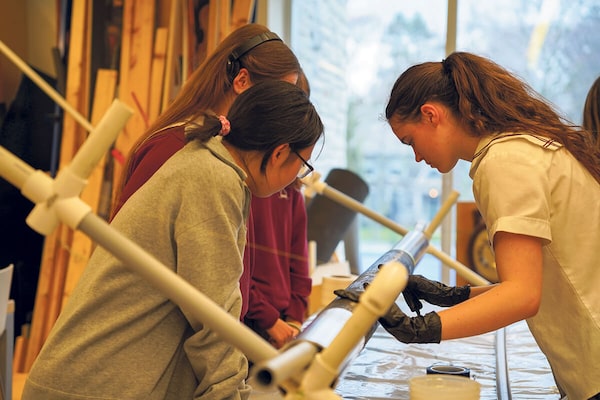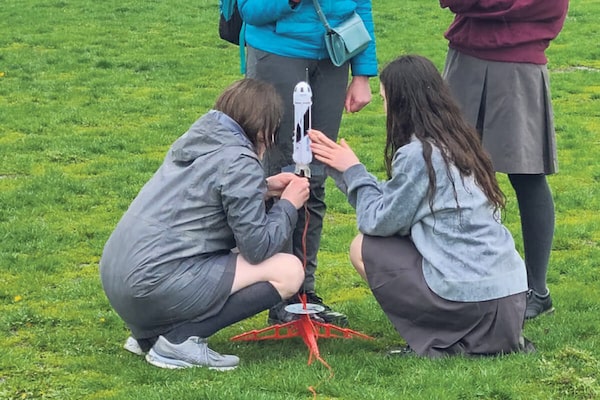
The members of the BSS Rocketry Team designed and built a rocket and are preparing to take part in the Launch Canada Competition in August 2024. They are the first high school team and first all-girls team to compete at the university-level rocketry event.Supplied
It is a project not typically associated with a high school education – building a working rocket and preparing to compete with other “rocketeers” in a launch competition.
But this is a real challenge for high school students in the first-ever Rocketry Team at The Bishop Strachan School (BSS) in Toronto – an independent school for girls from Junior Kindergarten to Grade 12.
“One of the reasons students created this team was to break barriers and inspire more students to get involved in STEM,” says Dimple Patel, vice principal, student life and belonging, at BSS. “Through this work, students are showcasing their technical skills, along with leadership, teamwork and creativity.”
Led by a Grade 10 student, the team is building a 2.4-metre (8-foot) rocket that aims to break the sound barrier (1,234 km/hr), as well as complete a payload experiment and touchdown for a successful recovery.
And barriers are indeed being broken: the Rocketry Team will be the first high school team and first all-girls team to compete at the university-level Launch Canada Competition in Timmins, Ontario, in August 2024.
Becoming future-ready through extracurricular activities and academics
Rocketry is just one of the student-led initiatives to help BSS students to explore their passions and build competencies to succeed in future careers in STEM (science, technology, engineering and math) and STEAM – which integrates the arts into STEM disciplines and amplifies focus on creativity, innovation and critical thinking.
Two student leaders assembled four robotics teams who participated this year in several tournaments in the VEX Robotics competition. Among the accomplishments of the BSS teams: Competing among 71 global teams at the Canadian Open Signature Robotics Tournament in January, BSS was the only Canadian school team in Ontario to advance to Round 16.

Supplied
Three BSS students participated in the Toronto Science Fair in March, and all three students placed, including one who won gold for an investigation of the use of music therapy in the treatment of memory impairment.
While interdisciplinary design projects are underway in numerous extracurricular teams and clubs, they are also animating BSS classrooms and labs. The school integrates STEM and STEAM into academics for all grades and all subjects, from math and science to literature, languages and the creative arts.
“At BSS, we are helping students learn about new technologies and how to apply them in engineering, design thinking and creativity,” says Kristen Clarke, dean of teaching and learning.
Kristen Clarke" At BSS, we are helping students learn about new technologies and how to apply them in engineering, design thinking and creativity. We see (the Technological Education credit) as another way to allow students to learn about, engage in and embrace technology while developing important transferable skills.
Dean of Teaching and Learning, The Bishop Strachan School
Dr. Clarke says the school has embraced the new Technological Education credit that the Ontario Ministry of Education is now requiring for high school students and plans to create a fulsome pathway through the senior school for computer science and engineering.
“We see it as another way to allow students to learn about, engage in and embrace technology while developing important transferable skills,” she says.
Developing future designers and innovators in all fields
As technology innovation continues to transform every field and area of life, students at BSS are given opportunities to learn how to create, design and build everything from innovative technology tools to leading-edge artistic expressions.
In Grade 7 science, technology, creativity and environmental sustainability are coming together for an enriched learning experience. Students use Scratch, a block-based coding platform, to model scientific concepts on topics from particle theory to greenhouse gas effects. Then they had freedom to represent their results through animation, games or interactive storytelling.
The school is also integrating STEAM into the curriculum by teaching students how to make smart choices around ways to digitally communicate, model and leverage artificial intelligence (AI).
One example is the Advanced Placement research course for BSS students in Grade 12.
Students use generative AI tools to find bias in research sources and ensure a breadth of perspectives in their own research, explains BSS learning research specialist Dr. Alana Bell. They were taught how to use AI tools to search scientific databases, collect a series of references and compare research findings in the different papers.
“Students could then determine if they needed to do a deeper dive into the paper or to pass on that source. Students integrated technology in a practical way to not only help them do the research but also improve the strength of their arguments,” says Dr. Bell.
In the classroom and beyond, students at BSS are acquiring the knowledge and skills to step into the careers of tomorrow – many of them yet to be imagined and brought to life.
“In our increasingly complex and divided world, our responsibility is to facilitate learning so that every girl and young woman has not only the technical skills but also the bravery, commitment and know-how to make it better,” says Dr. Clarke.
Advertising feature produced by Randall Anthony Communications. The Globe’s editorial department was not involved.